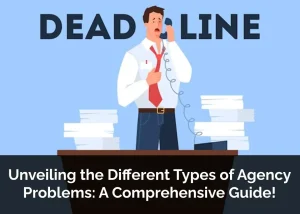The world of finance is a complex and ever-changing landscape. One of the most critical relationships in finance is the one between bondholders and managers. Bondholders are investors who have lent money to a company in exchange for interest payments and a promise of repayment at some point in the future.
Managers, on the other hand, are responsible for running the company and making decisions that affect its financial performance and the value of its debt and equity securities. While the bondholders and managers both have a vested interest in the success of the company, they often find themselves at odds over key issues such as dividend payments, debt restructuring, and corporate governance.
These conflicts can arise due to differences in incentives, risk appetite, and information asymmetry between the two parties.
In this blog post, we will explore the various conflicts that can arise between bondholders and managers in finance. We will examine the reasons behind these conflicts and the potential consequences for both parties.
Bondholders want their money back
Bondholder-manager conflict is a common issue in finance, where bondholders and managers often have competing interests. One of the main sources of conflict is bondholders’ desire to have their money back. Bondholders are investors who lend money to companies by purchasing bonds, which are debt securities that pay interest.
When a company issues bonds, it agrees to pay interest on the bonds and to repay the principal amount at a future date. However, managers may decide to use the company’s cash for other purposes, such as investing in new projects or paying dividends to shareholders, instead of repaying the bondholders.
This can create a conflict between bondholders and managers, as bondholders may feel that the managers are not acting in their best interest by delaying or failing to repay their debt. It is important for companies to balance the interests of bondholders and managers to avoid damaging their reputation and losing investor trust.
Earn a certificate in your dream career for an affordable price at IAP Career College today!
Managers prioritize company growth
Bondholder-manager conflict arises when the interests of bondholders and managers diverge, causing them to disagree on the optimal course of action for the company. One common source of conflict is when managers prioritize company growth over bondholders’ interests.
While growth is important for the long-term success of a company, managers should not do so at the expense of bondholders who may be more concerned with the company’s ability to generate cash flow to pay off their bonds. Managers must balance growth with the financial obligations owed to bondholders to avoid breaching debt covenants or defaulting on bond payments.
Communication and transparency between managers and bondholders are key to managing this conflict. Managers should provide regular updates on the company’s financial health and growth plans to bondholders and work to find a mutually beneficial solution that satisfies both parties.
Debt can restrict firm flexibility
One of the key issues in the bondholder-manager conflict is the restriction of firm flexibility due to debt obligations. Debt is a double-edged sword that can provide a company with necessary funds for growth and expansion, but also limit its ability to make strategic decisions. When a company has significant debt, it must prioritize debt service payments over other investments, such as research and development or marketing initiatives.
This can hinder a company’s ability to adapt to changing market conditions and seize new opportunities. Additionally, debt covenants may impose restrictions on a company’s actions, limiting its ability to make certain decisions without the approval of lenders. For these reasons, it is crucial for companies to carefully consider their debt levels and the impact on their flexibility before taking on additional debt.
Equity holders may lose out
Bondholder-manager conflict arises when bondholders and managers have opposing interests, particularly in situations where a company is financially distressed. In these circumstances, managers may prioritize their own interests, such as the preservation of their jobs or their own compensation, over the interests of bondholders who have invested in the company’s debt.
This can lead to situations where managers delay or avoid taking necessary steps to address financial issues, such as reducing expenses or selling assets, which could benefit bondholders. As a result, bondholders may experience losses, particularly if the company is forced to declare bankruptcy or default on its debt.
Equity holders may also lose out in these situations, as they may be left with little to no value in the company. It is important for companies to address these conflicts and ensure that the interests of all stakeholders, including bondholders and equity holders, are taken into account in decision-making.
Agency problems create conflict
Agency problems can create conflicts between bondholders and managers in finance, leading to what is known as bondholder-manager conflict. This conflict arises when the interests of bondholders, who are looking to maximize their returns on investment, clash with those of managers, who may prioritize other objectives, such as expansion or growth.
Managers may choose to invest in risky projects that offer high returns but also carry a high level of default risk, which could negatively impact bondholders. Bondholders may demand conservative investment strategies to protect their investment, while managers may resist such strategies in favor of more ambitious projects.
It is important for companies to find a balance between the two parties to prevent bondholder-manager conflicts and ensure the success of the organization as a whole.
Bondholders may demand control
One of the key issues that arises in bondholder-manager conflict is the potential for bondholders to demand control. This occurs when bondholders become concerned about the financial health of a company and its ability to repay its debts.
As a result, they may seek to exert greater influence over the decision-making processes of the company in order to protect their investments. This can create tension between bondholders and managers, as managers may view such demands as a threat to their authority and autonomy.
The potential for bondholders to demand control highlights the importance of effective communication and transparency between managers and bondholders. By maintaining open lines of communication and providing regular updates on the company’s financial health, managers can help to alleviate concerns among bondholders and mitigate the risk of conflicts arising.
Managers may prioritize dividends
One of the key conflicts that can arise between bondholders and managers is related to dividend payments. Managers may prioritize paying dividends to shareholders over repaying debt to bondholders, which can result in delayed or missed bond payments.
This bondholder-manager conflict can be particularly significant if the company is facing financial difficulties or if it is unable to generate sufficient cash flows to meet all of its obligations. Bondholders may feel that their investments are at risk and may demand higher interest rates or other protections to compensate for the increased risk.
It is important for managers and bondholders to communicate and work together to find a mutually beneficial solution that prioritizes the long-term financial health of the company.
Convertible bonds can mitigate conflict
Convertible bonds can be an effective tool to mitigate bondholder-manager conflicts in finance. In a typical bondholder-manager conflict scenario, managers may prioritize their own interests over those of the bondholders, leading to a decline in the bond’s value.
Convertible bonds, however, provide an added layer of protection for bondholders by enabling them to convert their bonds into equity. This reduces the conflict between bondholders and managers since the bondholders become equity owners and have a greater say in the company’s decisions.
Additionally, the conversion feature incentivizes managers to make decisions that drive the company’s stock price up, benefiting both the managers and the bondholders. Overall, convertible bonds offer a unique solution to bondholder-manager conflict by aligning the interests of both parties and promoting a more cooperative relationship.
Credit rating affects bondholders
Bondholder-manager conflict is a common issue in finance that arises when the interests of bondholders and managers are not aligned. One aspect of this conflict is the impact that credit ratings can have on bondholders.
Credit ratings are assessments of a company’s ability to pay back its debts, and they can significantly affect the interest rates that bondholders receive. If a company’s credit rating drops, bondholders may face a higher risk of default and may demand higher interest rates to compensate for that risk.
Conversely, if a company’s credit rating improves, bondholders may be willing to accept lower interest rates. As such, managers have an incentive to maintain or improve the company’s credit rating to keep bondholders happy and maintain access to capital markets.
However, this may conflict with other goals, such as maximizing short-term profits, which can lead to decisions that hurt the company’s credit rating and bondholders’ interests in the long run.
Bond covenants can restrict management
One of the most common conflicts that arise between bondholders and managers is related to bond covenants. These covenants are put in place to protect bondholders’ interests by limiting the amount of risk that the company can take on.
However, they can also restrict management’s ability to make certain decisions, as failure to comply with these covenants can result in penalties or even default on the bond. This can create a bondholder-manager conflict if management wants to take on more risk than allowed by the covenants, or if they feel that the covenants are too restrictive.
It is important for both parties to communicate and work together to find a balance between managing risk and maximizing returns. Failure to do so can lead to a breakdown in trust and potentially harm the financial well-being of the company and its stakeholders.
Conclusion: Addressing Bondholder-Manager Conflicts
In conclusion, the conflicts between bondholders and managers in finance are complex and multifaceted. Bondholders want to maximize their returns by ensuring that the company operates efficiently and meets its financial obligations, while managers have their own interests in growing the company and maximizing shareholder value.
It’s important for both parties to communicate effectively and work towards a mutually beneficial solution. With the right balance and approach, conflicts between bondholders and managers can be resolved and lead to positive outcomes for all involved.
FAQs:
What are the conflicts between bondholders and shareholders?
Bondholders and shareholders are the two main groups of investors in a company. Bondholders are creditors who have lent money to the company in exchange for a fixed interest rate and a promise of repayment on a specific date. Shareholders are the owners of the company who have purchased shares of its stock.
Bondholders and shareholders have different interests in the company, which can lead to conflicts. Some of the most common conflicts include:
- Dividend policy: Shareholders prefer to receive high dividends, while bondholders prefer the company to retain cash to reduce its debt.
- Investment policy: Shareholders may be willing to take on more risk in order to increase the company’s profits, while bondholders may prefer the company to invest in safer assets to reduce the risk of default.
- Capital structure: Shareholders may prefer the company to use more debt financing, which can increase the company’s leverage and potential returns. Bondholders, on the other hand, prefer the company to use more equity financing, which reduces the company’s leverage and risk of default.
- Asset substitution: Shareholders may be tempted to sell the company’s assets and distribute the proceeds to shareholders as dividends. This can harm bondholders, who may lose their collateral if the company defaults on its debt.
- Underinvestment: Shareholders may be reluctant to invest in new projects if they believe that the benefits will accrue to future shareholders rather than themselves. This can harm bondholders, as it can reduce the company’s profitability and ability to repay its debt.
To mitigate these conflicts, bondholders and shareholders can negotiate and include protective covenants in bond contracts. Protective covenants are restrictions on the company’s activities that are designed to protect bondholders’ interests. For example, a protective covenant may limit the amount of dividends that the company can pay, or restrict the company from selling certain assets.
It is important to note that these conflicts are not always irreconcilable. In many cases, shareholders and bondholders can align their interests by working together to achieve common goals, such as increasing the company’s profitability and reducing its risk.
What is the conflict between managers and creditors?
The conflict between managers and creditors is a type of agency problem that arises when managers act in their own interests, which may not be aligned with the interests of creditors. Creditors are interested in the company repaying its debt, while managers may be more interested in maximizing their own compensation or pursuing risky projects that could increase the company’s value, even if they also increase the risk of default.
Some specific examples of conflicts between managers and creditors include:
- Excessive risk-taking: Managers may take on more risk than is in the best interests of creditors in order to maximize their own compensation or increase the company’s value. For example, managers may invest in risky projects or borrow more money than the company can afford to repay.
- Asset substitution: Managers may sell the company’s assets and distribute the proceeds to shareholders as dividends, even if this reduces the company’s ability to repay its debt.
- Underinvestment: Managers may be reluctant to invest in new projects if they believe that the benefits will accrue to future shareholders rather than themselves. This can reduce the company’s profitability and ability to repay its debt.
- Excessive compensation: Managers may pay themselves excessive compensation, even if this reduces the company’s profits and ability to repay its debt.
Creditors can mitigate the conflict between managers and creditors by negotiating and including protective covenants in loan agreements. Protective covenants are restrictions on the company’s activities that are designed to protect creditors’ interests. For example, a protective covenant may limit the amount of dividends that the company can pay, or restrict the company from selling certain assets.
Creditors can also monitor the company’s financial performance and take steps to protect their interests if they believe that the company is at risk of default. For example, creditors may demand that the company sell assets or reduce its debt. In severe cases, creditors may force the company into bankruptcy.
It is important to note that the conflict between managers and creditors is not always irreconcilable. In many cases, managers and creditors can align their interests by working together to achieve common goals, such as increasing the company’s profitability and reducing its risk.
What conflicts of interest between bondholders and shareholders of a firm result in costs?
Conflicts of interest between bondholders and shareholders of a firm can result in a number of costs, including:
- Higher cost of capital: Bondholders may require a higher interest rate on their loans if they believe that the company is taking on too much risk or that the shareholders are not acting in their best interests. This can increase the cost of capital for the company, making it more difficult to raise money and finance new projects.
- Reduced investment: Shareholders may be reluctant to invest in new projects if they believe that the benefits will accrue to future shareholders rather than themselves. This can reduce the company’s profitability and ability to repay its debt, which can harm bondholders.
- Suboptimal decision-making: Managers may be caught in the middle of the conflict between bondholders and shareholders, and may make decisions that are not in the best interests of either group. For example, managers may delay necessary investments or take on too much risk in order to please shareholders, even if this harms bondholders.
- Increased monitoring costs: Bondholders may need to spend more money monitoring the company’s financial performance and taking steps to protect their interests if they believe that the company is at risk of default. This can increase the overall cost of capital for the company.
- Reduced creditworthiness: If the conflict between bondholders and shareholders is severe, it can damage the company’s creditworthiness and make it more difficult to raise money in the future. This can harm both bondholders and shareholders.
In addition to these economic costs, the conflict between bondholders and shareholders can also lead to a number of other negative consequences, such as:
- Increased litigation: If bondholders and shareholders believe that their interests are not being protected, they may file lawsuits against the company or its managers. This can be costly and time-consuming for the company, and can damage its reputation.
- Reduced employee morale: Employees may be demoralized if they believe that the company is not being managed in their best interests. This can lead to decreased productivity and increased turnover.
- Reduced customer confidence: Customers may be less likely to do business with a company if they believe that the company is not being managed well. This can damage the company’s brand and reputation.
Overall, the conflict between bondholders and shareholders can have a significant negative impact on the company’s performance and value. It is important for companies to manage this conflict carefully in order to protect the interests of all stakeholders.
What are the different types of conflicts in financial management?
There are many different types of conflicts that can arise in financial management. Some of the most common types include:
- Conflicts of interest: A conflict of interest occurs when an individual or organization has a personal interest that could influence their professional judgment. For example, a financial advisor might have a conflict of interest if they recommend a product to a client that they also own stock in.
- Agency problems: An agency problem occurs when one party (the agent) is acting on behalf of another party (the principal), but the agent’s interests are not aligned with the principal’s interests. For example, a manager might have an agency problem if they make decisions that benefit themselves at the expense of the company’s shareholders.
- Risk management conflicts: Risk management conflicts arise when there is disagreement about how much risk a company should take on. For example, shareholders may be willing to take on more risk in order to increase the company’s profitability, while bondholders may prefer the company to take on less risk to reduce the risk of default.
- Behavioral biases: Behavioral biases are mental shortcuts that can lead to irrational financial decision-making. For example, a manager might be biased towards making investments that they are familiar with, even if they are not the best investments for the company.
In addition to these general types of conflicts, there are also a number of more specific conflicts that can arise in financial management. For example, there may be conflicts between:
- Different departments: For example, the sales department may want to increase spending on marketing in order to boost sales, while the finance department may want to reduce spending in order to improve the company’s bottom line.
- Different levels of management: For example, junior managers may want to invest in new projects to increase their chances of promotion, while senior managers may be more focused on short-term profits.
- Different stakeholders: For example, shareholders may want the company to distribute more profits as dividends, while bondholders may want the company to retain its cash to reduce its debt.
It is important to be aware of the different types of conflicts that can arise in financial management so that they can be managed effectively. Some common strategies for managing conflict include:
- Transparency: Being transparent about all financial information and decisions can help to build trust and reduce the risk of conflict.
- Communication: Open and honest communication between all stakeholders is essential for resolving conflict.
- Collaboration: By working together, stakeholders can find solutions that meet the needs of all parties involved.
- Compromise: Sometimes, it is necessary to compromise in order to resolve conflict. This means that all parties involved may need to give up something in order to reach an agreement.
By managing conflict effectively, financial managers can help to create a more productive and efficient work environment. This can lead to better financial outcomes for the company and its stakeholders.





